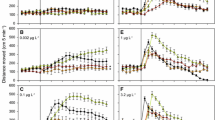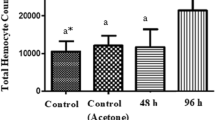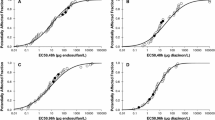Abstract
Microencapsulated permethrin (penncapthrin) was evaluated under laboratory conditions for its toxicity toward several nontarget aquatic invertebrates. Average LC50 estimates for selected lotic invertebrates, based on a one hour dosing regime, were: 2.71 mg/L forSimulium vittatum, 4.59 mg/L forHydropsyche spp., and 13.41 mg/L forIsonychia bicolor. In acute static tests withDaphnia magna, there was no significant difference (p≤0.05) between the toxicity of penncapthrin at 96 h (LC50 range: 6.80–22.5 μg/L) and the EC formulation at 72 h (LC50 range: 0.6–21 μg/L). Comparatively, the toxicity of microencapsulated methyl parathion (penncap-m) was not significantly different from that of penncapthrin towardD. magna, the former having LC50 estimates ranging form 0.3–12.25 μg/L. LC50 estimates associated withDaphnia pulex ranged from 19 to 131 μg/L. The toxicity of penncapthrin and penncap-m towardD. pulex was difficult to determine because of frequent control mortality due to food deprivation resulting from the need to run tests for longer than 48 h. In successful tests, LC50 estimates ranged from 19 to 28 μg/L for penncapthrin and 0.08 to 25 μg/L for penncap-m after 72 h exposure. In long term toxicity tests, 95% of D. magna at 1 μg/L, 44% at 10 μg/L, and 20% at 15 μg/L survived after 39 days exposure. Less than 15% ofD. pulex survived over the same concentration range following 32 days exposure. Despite some drawbacks, long-term toxicity tests were more appropriate than short-term tests for evaluating microencapsulated sticides because of reduced variability in LC50 estimates and lower control mortality.
Similar content being viewed by others
References
Abbott MS (1925) A method of computing the effectiveness of an insecticide. J Econ Entomol 18:265–267
Adema DMM (1978)Daphnia magna as a test animal in acute and chronic toxicity tests. Hydrobiologia 59:125–134
Ali A, Marjori G, Ceretti G, D'Andrea F, Scattolin M, Ferrarese U (1985) A chironomid (Diptera: Chironomidae) midge population study and laboratory evaluation of larvicides against midges inhabiting the lagoon of Venice, Italy. J Am Mosq Control Assoc 1:63–69
Bath TD, Vandegrift AE, Hermann TS (1970) Concentration profiles downstream from instantaneous pollution loadings. J Water Pollut Contr Fed 42:582–595
Braimah SA (1987) Mechanisms of filter feeding in immatureSimulium bivittatum Malloch (Diptera: Simuliidae) andIsonychia campestris (Ephemeroptera: Oligonuridae). Can J Zool 65:504–513
Cardarelli N (1975) Concepts in controlled release: Emerging pest control technology. Chemtech 5:482–485
Casida JE, Gammon DW, Glickman AH, Lawrence LJ (1983) Mechanisms of selective actions of pyrethroid insecticides. Ann Rev Pharmacol Toxicol 23:413–438
Daniels RE, Allen JD (1981) Life table evaluation of chronic exposure to a pesticide. Can J Fish Aquat Sci 38:485–494
Evans ES Jr, Nelson JH, Pennington NE, Young WW (1975) Larvicidal effectiveness of a controlled-release formulation of chlorpyrifos in a woodland pool habitat. Mosq News 35:343–349
Fanger GO (1974) What good are microcapsules? Chemtech 4:397–405
Finney DJ (1970) Probit analysis. 3rd edition. Cambridge University Press, 333 pp
Fogle MV (1968) Microencapsulation promises big potential in agricultural field. Croplife, February (pp 20–22)
Hayat MA (1978) Introduction to biological scanning electron microscopy. University Park Press, London. 323 pp
James T (1985) PARASTAT. Computerized parametric statistical package. University of Guelph, Canada
Jarvinen AW, Tanner DK (1982) Toxicity of selected controlled release and corresponding unformulated technical grade pesticides to the fathead minnowPimephales promelas. Environ Pollut (Series A) 27:179–195
Johnson P, Lloyd-Jones JP (1989) Drug delivery systems. Fundamentals and techniques. Ellis Horwood, New York, 282 pp
Kingsbury PD, Kreutzweiser DP (1987) Permethrin treatments in Canadian forests. Part I: Impact on stream fish. Pest Sci 19:35–48
Ladle M, Bass JAB, Jenkins WR (1972) Studies on production and food consumption by the larval Simuliidae of a chalk stream. Hydrobiologia 39:429–448
Lewis DH, Cowsar DR (1977) Principles of controlled release pesticides. In: Scher HB (ed) Controlled release pesticides. Am Chem Soc Symposium 53, Washington, DC pp 1–17
Luzzi LA (1970) Microencapsulation. J Pharm Sci 59:1367–1376
Marshall JS (1978) Population dynamics ofDaphnia galeata mendotae as modified by cadmium stress. J Fish Res Board Can 35:461–469
McCarthy JR (1983) Role of particulate organic matter in decreasing accumulation of polynuclear hydrocarbons byDaphnia magna. Arch Environ Contam Toxicol 12:559–568
Meghir S (1984) Microencapsulation of insecticides by interfacial polycondensation: The benefits and problems. Pest Sci 15:265–268
Miles JW, Woehst E (1969) Formulations for controlled release of abate in water. In: Pesticide Formulation Research: Physical and Colloidal Chemical Aspects. Adv Chem Ser #86, Am Chem Soc Washington DC, pp 183–191
Miles JW, Pearce GW, Woehst E (1962) Stable formulations for sustained release of DDVP. J Agric Food Chem 10:240–244
Moshen ZH, Mulla MS (1981) Toxicity of blackfly larvicide formulations to some aquatic insects in the laboratory. Bull Environ Contam Toxicol 26:696–703
Muirhead-Thomson RC (1977) Comparative tolerance levels of blackflies (Simulium) larvae to permethrin (NRDC 143) and temephos. Mosq News 37:172–179
Muirhead-Thomson RC (1978) Lethal and behavioural impact of permethrin (NRDC 143) on selected stream macroinvertebrates. Mosq News 38:185–190
Mulla MS, Darwezah HA (1976) Field evaluation of new mosquito larvicides and their impact on some non-target insects. Mosq News 36:251–256
Mulla MS, Lacey LA (1976) Field evaluation of new mosquito larvicides and their impact on some non-target insects. Environ Entomol 5:283–287
Mulla MS, Navvab-gorjrati HA, Darwezah HA (1978) Biological activity and longevity of new synthetic pyrethroids against mosquito larvae and some non-target insects. Mosq News 38:90–96
Nebeker AV (1982) Evaluation of aDaphnia magna renewal lifecycle test method with silver and endosulfan. Wat Res 16:739–744
Nelson LL, Barnes WW, Harris FW, Lawson MA (1970) Evaluation of release rates of Dursban® from polyvinyl chloride formulations. J Econ Entomol 63:1870–1873
Rodrigues CS, Kaushik NK. (1984) A bioassay apparatus for the evaluation of blackfly (Diptera: Simuliidae) larvicides. Can Entomol 116:75–78
Rodrigues CS, Molloy CD, Kaushik NK (1983) Laboratory evaluation of microencapsulated formulations of chlorpyrifos-methyl against blackfly larvae (Diptera: Simuliidae) and selected nontarget invertebrates. Can Entomol 115:1189–1201
Sharom MS, Solomon KR (1981) Adsorption-desorption, degradation and distribution of permethrin in aqueous systems. J Agric Food Chem 29:1122–1125
Sibley PK (1989) Impact of permethrin (emulsifiable concentrate) on the macroinvertebrate community of a headwater stream and of microencapsulated permethrin under laboratory conditions. MSc thesis, University of Guelph, Guelph, Canada, 160 pp
Surendar Kumar RL, Bhatnagar P (1988) Uptake of dieldrin, dimethoate, and permethrin by cyanobacteria,Anabeana sp., andAulosira fertilissima. Environ Pollut 54:55–61
Ten Berge WF (1978) BreedingDaphnia magna. Hydrobiologia 59:121–123
Veith GD and Comstock VM (1975) Apparatus for continuously saturating water with hydrophobic organic chemicals. J Fish Res Board Can 32:1849–1851
Wallace JB, O'Hop J (1979) Fine particle suspension-feeding capabilities ofIsonychia spp. (Ephemeroptera: Siphlonuridae). Ann Entomol Soc Am 72:353–357
Ware GW (1983) Pesticides. Theory and application. WH Freeman, New York, 308 pp
Winner RW, Farrell MP (1978) Acute and chronic toxicity of copper to four species ofDaphnia. J Fish Res Board Can 33:1685–1691
Zweig G (1977) Environmental aspects of controlled release pesticide formulations. In: Scher HB (ed) Controlled Release Pesticides. Am Chem Soc Symp Series 53, Am Chem Soc Washington DC, pp 37–53
Author information
Authors and Affiliations
Rights and permissions
About this article
Cite this article
Sibley, P.K., Kaushik, N.K. Toxicity of microencapsulated permethrin to selected nontarget aquatic invertebrates. Arch. Environ. Contam. Toxicol. 20, 168–176 (1991). https://doi.org/10.1007/BF01055901
Received:
Revised:
Issue Date:
DOI: https://doi.org/10.1007/BF01055901




